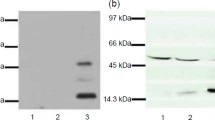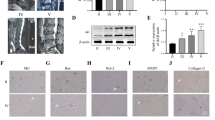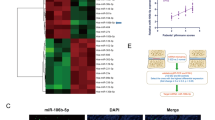Abstract
RNA interference (RNAi) technology has recently emerged as an important biological strategy for gene silencing. Previously, the efficacies of RNAi in cultured nucleus pulposus cells in vitro have been reported. However, RNAi in the disc in vivo has never been reported. Therefore, the aims of the present study were to establish a method for RNAi in the disc in vivo and to evaluate the applicability of this technique for endogenous genes in the intervertebral discs using Fas Ligand (FasL) as a representative endogenous gene. To evaluate the efficacy of RNAi in vivo, two reporter luciferase plasmids (Firefly and Renilla) were used. These plasmids and unmodified short interference RNA (siRNA) duplex for targeting Firefly luciferase were co-transfected into coccygeal intervertebral disc of Sprague-Dawley rats in vivo using the ultrasound gene transfer technique. To evaluate the RNAi of the endogenous gene in vivo, siRNAs targeting rat FasL were transfected with the same technique. Non-specific siRNA was used as the negative control. The discs receiving no siRNAs were used as the control. The inhibitory effect of Firefly luciferase against Renilla luciferase was obtained using the results of dual-luciferase assay. Down-regulation of endogenous FasL was calculated by the data from real-time PCR. Our results showed that siRNA for Firefly luciferase can dramatically down-regulate the Firefly luciferase gene expression in vivo compared with Renilla luciferase. The inhibitory effects were maintained for at least 24 weeks and at 24 weeks post transfection, the inhibitory rate was 80% compared with the control group. Furthermore, the siRNA co-transfection group inhibited endogenous FasL expression by 53% compared with the control group. The present study demonstrates long-term down-regulation mediated by unmodified siRNA is possible not only for the exogenous reporter gene, but also for endogenous FasL expression in rat discs in vivo. This application of RNAi might be promising as a local therapy for disc degeneration and associated disorders by down-regulating some of the genes that are harmful for the normal physiology of the disc and may cause disc degeneration.




Similar content being viewed by others
References
Aigner A (2006) Gene silencing through RNA interference (RNAi) in vivo: strategies based on the direct application of siRNAs. J Biotechnol 124:12–25. doi:10.1016/j.jbiotec.2005.12.003
Akaneya Y, Jiang B, Tsumoto T (2005) RNAi-induced gene silencing by local electroporation in targeting brain region. J Neurophysiol 93:594–602. doi:10.1152/jn.00161.2004
Anderson GB (1999) Epidemiological features of chronic low-back pain. Lancet 354:581–585. doi:10.1016/S0140-6736(99)01312-4
Carter PJ, Samulski RJ (2000) Adeno-associated viral vectors as gene delivery vehicles. Int J Mol Med 6:17–27
Elbashir SM, Harborth J, Lendeckel W, Yalcin A, Weber K, Tuschl T (2001) Duplexes of 21-nucleotide RNAs mediate RNA interference in cultured mammalian cells. Nature 411:494–498. doi:10.1038/35078107
Fire A, Xu S, Montgomery MK, Kostas SA, Driver SE, Mello CC (1998) Potent and specific genetic interference by double-stranded RNA in Caenorhabditis elegans. Nature 391:806–811. doi:10.1038/35888
Fougerolles A, Manoharan M, Meyers R, Vornlocher HP (2005) RNA interference in vivo: toward synthetic small inhibitory RNA-based therapeutics. Methods Enzymol 392:278–296. doi:10.1016/S0076-6879(04)92016-2
Freemont AJ, Peacock TE, Goupille P, Hoyland JA, O’Brien J, Jayson MI (1997) Nerve ingrowth into diseased intervertebral disc in chronic back pain. Lancet 350:178–181. doi:10.1016/S0140-6736(97)02135-1
Golzio M, Mazzolini L, Moller P, Rols MP, Teissié J (2005) Inhibition of gene expression in mice muscle by in vivo electrically mediated siRNA delivery. Gene Ther 12:246–251. doi:10.1038/sj.gt.3302405
Grunhagen T, Wilde G, Soukane DM, Shirazi-Adl SA, Urban JP (2006) Nutrient supply and intervertebral disc metabolism. J Bone Joint Surg 88-A:30–35. doi:10.2106/JBJS.E.01290
Hannon GJ (2002) RNA interference. Nature 418:244–251. doi:10.1038/418244a
Heidel JD, Hu S, Liu XF, Triche TJ, Davis ME (2004) Lack of interferon response in animals to naked siRNAs. Nat Biotechnol 22:1579–1582. doi:10.1038/nbt1038
Herweijer H, Wolff JA (2003) Progress and prospects: naked DNA gene transfer and therapy. Gene Ther 10:453–458. doi:10.1038/sj.gt.3301983
Inui Y, Nishida K, Doita M, Takada T, Miyamoto H, Yoshiya S et al (2004) Fas-ligand expression on nucleus pulposus begins in developing embryo. Spine 29:2365–2369. doi:10.1097/01.brs.0000143172.07771.fc
Kakutani K, Nishida K, Uno K, Takada T, Shimomura T, Maeno K et al (2006) Prolonged down regulation of specific gene expression in nucleus pulposus cell mediated by RNA interference in vitro. J Orthop Res 24:1271–1278. doi:10.1002/jor.20171
Kim B, Tang Q, Biswas PS, Xu J, Schiffelers RM, Xie FY et al (2004) Inhibition of ocular angiogenesis by siRNA targeting vascular endothelial growth factor pathway genes: therapeutic strategy for herpetic stromal keratitis. Am J Pathol 165:2177–2185
Kim TW, Lee JH, He L, Boyd DA, Hardwick JM, Hung CF et al (2005) Modification of professional antigen-presenting cells with small interfering RNA in vivo to enhance cancer vaccine potency. Cancer Res 65:309–316
Kishida T, Asada H, Gojo S, Ohashi S, Shin-Ya M, Yasutomi K et al (2004) Sequence-specific gene silencing in murine muscle induced by electroporation-mediated transfer of short interfering RNA. J Gene Med 6:105–110. doi:10.1002/jgm.456
Lattermann C, Oxner WM, Xiao X, Li J, Gilbertson LG, Robbins PD et al (2005) The adeno associated viral vector as a strategy for intradiscal gene transfer in immune competent and pre-exposed rabbits. Spine 30:497–504. doi:10.1097/01.brs.0000154764.62072.44
Lawrie A, Brisken AF, Francis SE, Cumberland DC, Crossman DC, Newman CM (2000) Microbubble-enhanced ultrasound for vascular gene delivery. Gene Ther 7:2023–2027. doi:10.1038/sj.gt.3301339
Lentz G (2005) The RNA interference revolution. Braz J Med Biol Res 38:1749–1757
Masuda K, An HS (2006) Prevention of disc degeneration with growth factors. Eur Spine Suppl 3:S422–S432. doi:10.1007/s00586-006-0149-1
Matsuda T, Cepko CL (2004) Electroporation and RNA interference in the rodent retina in vivo and in vitro. Proc Natl Acad Sci USA 101:16–22. doi:10.1073/pnas.2235688100
Nachemson A (1969) Intradiscal measurements of pH in patients with lumbar rhizopathies. Acta Orthop Scand 40:23–42
Nachemson A, Elfstrom G (1970) Intravital dynamic pressure measurements in lumbar discs. A study of common movements, maneuvers and exercises. Scand J Rehabil Med Suppl 1:1–40
Nishida K, Kang JD, Suh JK, Robbins PD, Evans CH, Gilbertson LG (1998) Adenovirus-mediated gene transfer to nucleus pulposus cells. Implications for the treatment of intervertebral disc degeneration. Spine 23:2437–2442. doi:10.1097/00007632-199811150-00016
Nishida K, Kang JD, Gilbertson LG, Moon SH, Suh JK, Vogt MT et al (1999) Modulation of the biologic activity of the rabbit intervertebral disc by gene therapy: an in vivo study of adenovirus-mediated transfer of the human transforming growth factor beta 1 encoding gene. Spine 24:2419–2425. doi:10.1097/00007632-199912010-00002
Nishida K, Doita M, Takada T, Kakutani K, Miyamoto H, Shimomura T et al (2006) Sustained transgene expression in intervertebral disc cells in vivo mediated by microbubble-enhanced ultrasound gene therapy. Spine 31:1415–1419. doi:10.1097/01.brs.0000219945.70675.dd
Omi K, Tokunaga K, Hohjoh H (2004) Long-lasting RNAi activity in mammalian neurons. FEBS Lett 558:89–95. doi:10.1016/S0014-5793(04)00017-1
Peng B, Hao J, Hou S, Wu W, Jiang D, Fu X et al (2006) Possible pathogenesis of painful intervertebral disc degeneration. Spine 31:560–566. doi:10.1097/01.brs.0000201324.45537.46
Sakai D, Mochida J, Iwashima T, Watanabe T, Nakai T, Ando K et al (2005) Differentiation of mesenchymal stem cells transplanted to a rabbit degenerative disc model: potential and limitations for stem cell therapy in disc regeneration. Spine 30:2379–2387. doi:10.1097/01.brs.0000184365.28481.e3
Takabatake Y, Isaka Y, Mizui M, Kawachi H, Shimizu F, Ito T et al (2005) Exploring RNA interference as a therapeutic strategy for renal disease. Gene Ther 12:965–973. doi:10.1038/sj.gt.3302480
Takada T, Nishida K, Doita M, Kurosaka M (2002) Fas ligand exists on intervertebral disc cells: a potential molecular mechanism for immune privilege of the disc. Spine 27:1526–1530. doi:10.1097/00007632-200207150-00009
Taniyama Y, Tachibana K, Hiraoka K, Aoki M, Yamamoto S, Matsumoto K et al (2002) Development of safe and efficient novel nonviral gene transfer using ultrasound: enhancement of transfection efficiency of naked plasmid DNA in skeletal muscle. Gene Ther 9:372–380. doi:10.1038/sj.gt.3301678
Wallach CJ, Sobajima S, Watanabe Y, Kim JS, Georgescu HI, Robbins P et al (2003) Gene transfer of the catabolic inhibitor TIMP-1 increases measured proteoglycans in cells from degenerated human intervertebral discs. Spine 28:2331–2337. doi:10.1097/01.BRS.0000085303.67942.94
Waterhouse PM, Wang MB, Lough T (2001) Gene silencing as an adaptive defence against viruses. Nature 411:834–842. doi:10.1038/35081168
Zhang L, Nolan E, Kreitschitz S, Rabussay DP (2002) Enhanced delivery of naked DNA to the skin by non-invasive in vivo electroporation. Biochim Biophys Acta 1572:1–9
Acknowledgments
The authors thank Ms.Tubby for their help in preparing the manuscript. We also thank Ms. Yasuda and Ms. Tanaka for their sophisticated technical assistance. This work was supported by Grant-in-Aid for Scientific Research from the Ministry of Education, Culture, Sports, Science and Technology of Japan.
Author information
Authors and Affiliations
Corresponding author
Rights and permissions
About this article
Cite this article
Suzuki, T., Nishida, K., Kakutani, K. et al. Sustained long-term RNA interference in nucleus pulposus cells in vivo mediated by unmodified small interfering RNA. Eur Spine J 18, 263–270 (2009). https://doi.org/10.1007/s00586-008-0873-9
Received:
Revised:
Accepted:
Published:
Issue Date:
DOI: https://doi.org/10.1007/s00586-008-0873-9




